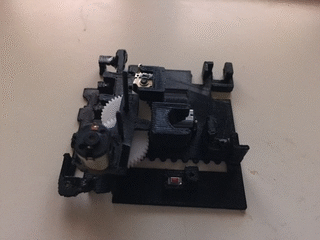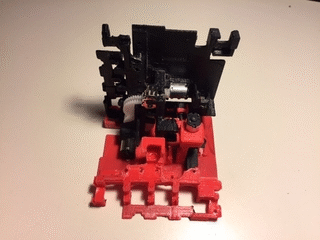I finally 3D-printed it and put the motors and sensors, aka buttons and the scroll for mice, where they should be. I made two sides so I verify the design. Test the grabbing and movement, I did not print the female handle because I wanted to test the other stuff first.
The white gear at the bottom in the gif below has a 3D-printed gear glued to it, like the yellow gears in the previous project log. And this is just a show gif showing that I had to take the chassi apart and then glue it back together (the last part with the motor). Otherwise I wouldn't be able to get all those things in there.

And as you can see the gears line up and the total reduction for the motor is 4^4 = 256, which then goes straight to the male handle from another cube. Fyi when that motor was running it sounded like a drilling machine. Imagine having 20 cubes moving simultaneously in front of you, lovely noise. On a serious note, it's not acceptable.
This is how one side of the cube looks from the inside 360 degrees. One motor is missing, but you'll see it later in the third gif.

Luckily everything fit snuggly on the first go, that usually never happens. And if you want to see more of this model then go download the file cube A. In the *.blend file I've divided the parts in 7 layers, if you're not familiar with blender then here's a crash course. Right click marks objects, G-button grabs the object you've marked, Left click accepts the movement the G-button did, or other similar actions. H-button hides selected object. If you want to see a particular layer you press that number on your keyboard, if you want to see more layers at the same time then hold down shift while pressing the different numbers. If you R-click an object, hit G and then Y, then you'll move the object in only the Y dimension.
Oh well, enough about Blender, in the next gif there's two sides screwed together, forming 1/3 of a cube. The reason for this is to verify that even the chassi fits snuggly, which it does. The red side has the male handle attached to it, and the motor worked splendid with the handle, moving it correctly 8mm out or all the way in. When it moved 8mm out there handle also stopped because it hit a button, aka a stop sensor.

So all is fine and dandy, then I take them apart and put them together as if they were two different cubes, which can be seen in the next gif. At this moment I see that the male handle is not moving out exactly 8mm, which it kind of must. Otherwise there won't be a splendid connecting with the female handle, and if that doesn't work then it's a major failure. But yeah, around this time I understand thanks to the 3D-printing that these handles have way too low tolerances, also that it's kind of hard to put the connectors inside the handles. I did not put any real connectors in the male handle which are shown in these gif's, and if I would've it would've taken too much time. So no, I don't like these handles at all.

So around this time I realize that I need to use better handles. Ones with good fitting and ones that I haven't 3D-printed, because it's time to do a reality check. Like, what kind of connectors are out there for circuits? Well... regular 2.54mm male headers 3x2 and 3x2 female headers are.... pretty awesome. And I used that for an old design I made in October last year... and that design looks like this youtube video below.
It's not perfect, but it's also not stupid. The... what should I call it... the grabber, is only moving 10mm in each direction, and the female headers are spaced 20mm apart. You might think "Harry... that's not smart, that means that the cube can't move from one female connector to another female connector". But here's where I say that it will always be two cubes next to each other, and while one is moving the grabber 10mm one way, the neighboring cube is moving it's grabber 10mm the other way => 20mm. And that way the cubes will literally "walk", like your legs, across the cubes. Also, I like these connector designs.
So, I 3D-printed the cube B model and one grabber, and it worked... kind of good, the male header didn't fit anywhere which is a major flaw in the design. The 3D-printed cube can be seen in the youtube video below.
I will have to excuse the amateurish background. And yes, I muted the video because it's 6 month's old and I blabbed nonsense in Swedish.
The notorious person can also calculate the number of motors needed, the grabber moves in 2 dimensions, it's used on 3 sides, every grabber..... GRABS... so that's 1 motor per grabber, 2*3+1*3 = 9 motors. That's half the number of motors needed compared to the other design I've been working on so far, cube A. The thing that costs the most in these LRPM-cubes will be the motors, they ain't cheap.
So in the end I'll have to re-design the cubes with handles like cube B and motors & sensors like cube A. Because that way this will actually work. I forgot to take a picture of it but the gears (yellow in the previous project log), they apparently don't work that well as gears when they only have 6 teeth. They work great like a music instrument because it sounds horrible, they also got stuck. So I 3D-printed them again with lower half with 6 teeth and upper half with 12 teeth. That way they could use the 6 teeth for the male handles and 12 teeth for synchronizing each other. And that... sure, it worked, but woaw, the resistance in the cog's, it was ridiculously difficult to turn the gears. I don't know why because two gears could rotate just fine with each other, however when it was 3 or more gears connected then it was like turning a locked door's handle, did not work at all. And that's the major reason for why I'm giving up the design for cube A.
So next on my agenda is to mix the designs of cube B and cube A together, and then this silly thingiverse-phase will be over, because I want to solder and do some programming!
Discussions
Become a Hackaday.io Member
Create an account to leave a comment. Already have an account? Log In.
Great work! It's really interesting to see the designs start to take shape. I think this is one of the most interesting projects on hackaday.io!
Are you sure? yes | no